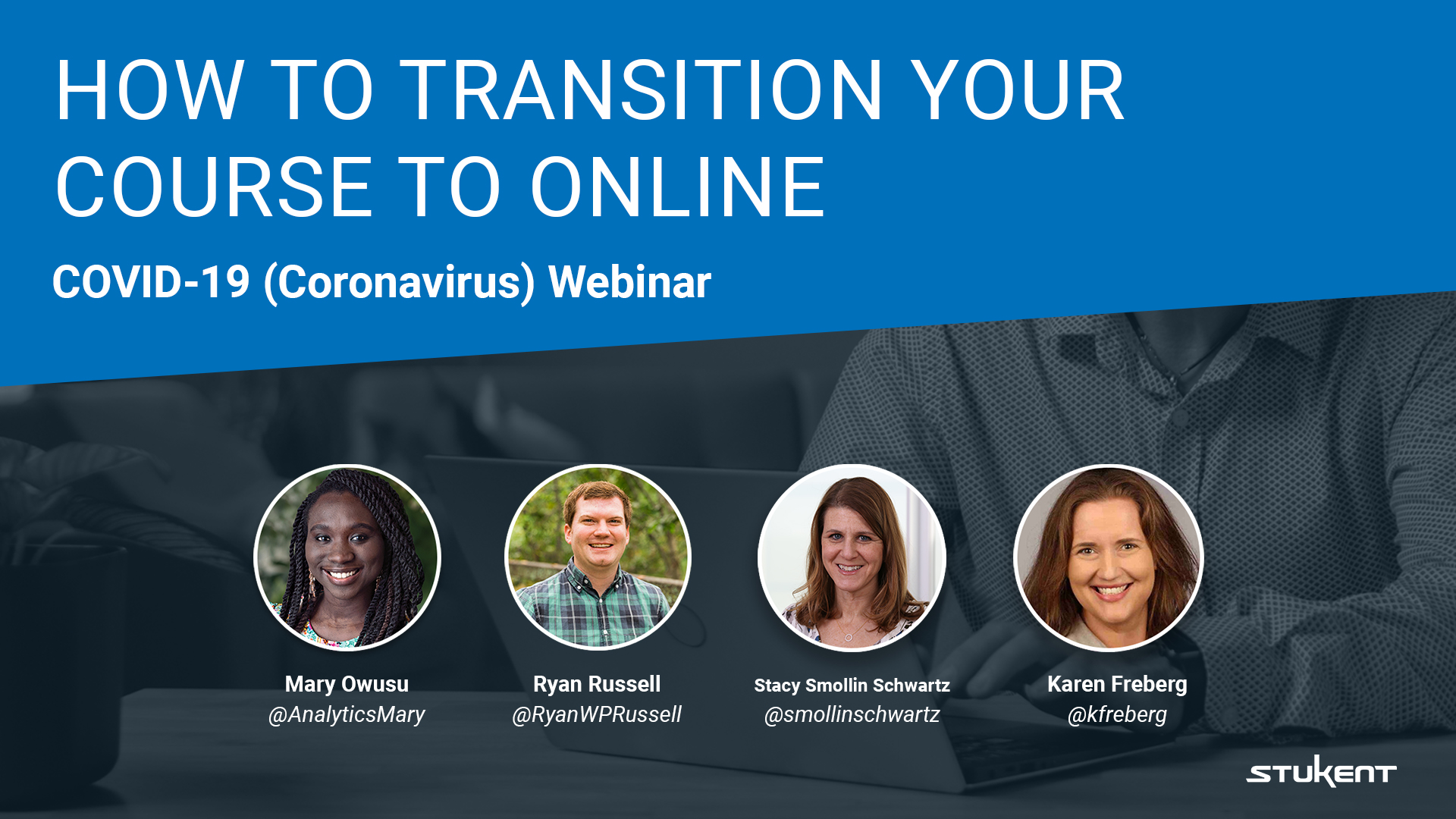The coronavirus outbreak has shutdown classrooms and left a lot of educators scrambling to transition their courses online with short notice. To help with the shift to virtual classrooms, Stukent hosted a free webinar featuring four experienced online educators who shared proven practices and tips for keeping students engaged online.
During the webinar, “How to Transition Your Course to Online,” attendees were able to draw on the knowledge of Karen Freberg of the University of Louisville, Ryan Russell of the University of Tennessee at Chattanooga, Mary Owusu of Canisius College, and Stacy Smollin Schwartz of Rutgers Business School.
Each panelist shared thoughts based on their own experience and responded to questions posed by webinar attendees. Below you will find highlights of the webinar. First, you’ll see the overall ideas from each panelist followed by topic-arranged takeaways shared during the webinar.
For access to more resources to help educators transition to online instruction, check out the “Additional Resources” section at the end of this article.
From the Panelists
Karen Freberg

Karen, who has 10 years of online teaching experience, shared with the audience that “… we are all in the same boat. We want the best for our students and moving forward.”
She recommended that instructors transitioning courses to online be kind to themselves in the process and evaluate their face-to-face courses to determine what could be transitioned for online delivery.
Karen advocated that instructors “create a human-to-human interaction so the students can see your face, they can see what you’re doing” to help break up text-heavy online learning experiences.
Ryan Russell

Ryan came to the webinar with about 5 years of online instructional experience in addition to his time teaching face-to-face. He is also an owner of a marketing agency.
Ryan acknowledged that classes transitioning from in-person to online “[are] marked with high levels of anxiety for people who didn’t sign up for an online course …”
With that recognition, Ryan said, “It does absolutely mean that our compassion … needs to be heightened for our students.” But he reminded instructors that “an increase in compassion does not mean a decrease in standards.” He explained that “your compassion and your communication certainly needs to increase with your students” but that doesn’t equate to a compromise in standards.
Mary Owusu

Mary is an assistant professor with years of adjunct experience teaching online while working in digital marketing.
In agreement with Ryan’s comments concerning students, Mary said, “Even though we are all in the heightened state of anxiety, I think our students are equally so.”
Mary advocated looking for the simplest approaches to providing students with quality educational content.
Stacy Smollin Schwartz

Stacy recently designed the new online digital marketing masters degree program at Rutgers University. For the past 10 years, she has primarily taught asynchronously online.
“The beauty of online is that you can be very iterative,” she said, indicating that changes can continue to be made as online classes go forward. She also gave attention to the importance of students maintaining peer connections within online settings.
“… [B]eing simple is better right now. This is not a planned online course,” she said, suggesting that instructors do what works for them. For example, you could have the class connect on Snapchat or Twitter. “Just like we have to be compassionate to the students, we have to be compassionate to ourselves,” Stacy said.
Takeaways by Topic
CHANGING SYLLABI
Stacy
Stacy created an “interruption” in her in-class syllabus that signified the beginning of online instruction. “And then I just changed the format of the way the syllabus was laid out for the rest of the semester,” she said, noting that it was “good for me to see that we’re still one course … we’re shifting but we’re still together …”
Ryan
He said that by following what Stacy shared, instructors are “doing a lot of course prep work” that can pay off later. “My encouragement would be, don’t waste this opportunity by just adapting. Document and record so that you can leverage those changes in the future …”
ENGAGING LEARNING
Mary
She suggested using asynchronous, pre-recorded lectures that are visually memorable and dividing lectures into small sections. She also recommended posting lectures as unlisted videos on YouTube.
Suggested resources:
- Screencastify, a Chrome screen recorder
- Nearpod, which allows for creation and delivery of online instruction
Stacy
Stacy provides students with the option to schedule synchronous online meetings with herself as the instructor and with other students during regularly scheduled class periods. She also gave the suggestion that instructors arrange for guest lectures to be presented to students.
IMPLEMENTING TESTING
Stacy
Stacy suggested, if instructors’ situations do not allow the use of Proctortrack, to lock the browser, establish time limits for tests, and have students show application of learning.
Suggested resource:
- Proctortrack, an online testing services provider
Ryan
Ryan advocated for recognition that students will be at home and that they may utilize outside materials. “Assume that [students] are going to be distracted because the environment is less controlled,” he said.
Suggested resource:
- Proctorio, an online testing services provider
HANDLING OFFICE HOURS
Karen
Karen polled students transferred to online instruction regarding time zone locations and if they were at home. She also got student feedback on whether work hours had changed and established virtual meeting times.
STUDENT PARTICIPATION
Ryan
Ryan suggested handling coursework submission through a learning management system.
Stacy
Stacy spoke of her plan to present students with questions at the conclusion of lectures. These questions will feed into course grades.
She recommended using online forums/boards to handle class discussions. A peer review mechanism, she indicated, could help handle class discussion forums/boards for courses with a large number of students.
Additional Resources
Stukent compiled a list of additional resources and tools to assist instructors in transitioning their courses online. Some were mentioned in the webinar, but many were not.
Karen also provided a number of blogs, groups, and videos for accessing educational resources, speaking of her success using the online video tool Zoom and talked of “reaching out to other professors,” giving attention to instructor Facebook groups.







